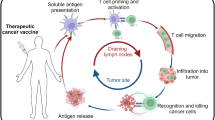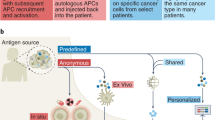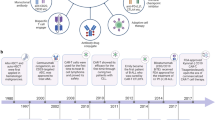Abstract
Myeloid leukemias, although a heterogeneous group of hematopoietic stem cell neoplasms, are arguably among the most suited for active specific immunotherapy. Nevertheless, clinical development of myeloid leukemia vaccine lagged behind similar approaches in other solid and hematological malignancies. The recent identification of apparently specific leukemia antigens and advances in understanding the fundamentals of tumor immunology have helped initiate a number of early phase clinical studies evaluating the safety and clinical efficacy of this approach. Here we review the recently identified and characterized putative leukemia antigens, the main vaccination strategies employed by most investigators and the results of clinical studies of immunotherapy of myeloid leukemias. Although these studies are early and often difficult to interpret, they offer evidence that effective immunity to leukemia could be induced following vaccination, and that clinical benefit can sometimes be observed, thus setting the stage for future development of this strategy and in the combinatorial approaches to treatment of myeloid leukemias that incorporate immunotherapy.
This is a preview of subscription content, access via your institution
Access options
Subscribe to this journal
Receive 12 print issues and online access
$259.00 per year
only $21.58 per issue
Buy this article
- Purchase on Springer Link
- Instant access to full article PDF
Prices may be subject to local taxes which are calculated during checkout

Similar content being viewed by others
References
Elghetany MT . Surface marker abnormalities in myelodysplastic syndromes. Hematologica 1998; 83: 1104–1115.
Bene MC . Immunophenotyping of acute leukemias. Immunol Lett 2005; 98: 9–21.
Notter M, Willinger T, Erben U, Thiel E . Targeting of B7-1 (CD80) immunoglobulin G fusion protein to acute myeloid leukemia blasts increases their costimulatory activity for autologous remission T cells. Blood 2001; 97: 3138–3145.
Bruserud O . Acute myelogenous leukemia blasts as accessory cells during T lymphocyte activation: possible implications for future therapeutic strategies. Leukemia 1999; 13: 1175–1178.
Lotem J, Sachs L . Hematopoietic cytokines inhibit apoptosis induced by transforming growth factor beta 1 and cancer chemotherapy compounds in myeloid leukemia cells. Blood 1992; 80: 1750–1757.
Jager D . Potential target antigens for immunotherapy identified by serological expression cloning (SEREX). Methods Mol Biol 2007; 360: 319–326.
Kurzrock R, Talpaz M . The molecular pathology of chronic myelogenous leukemia. Br J Hematol 1991; 79: 34–37.
Kessler JH, Bres-Vlooemans SA, van Veelen PA, de Ru A, Huijbers IJ, Camps M et al. BCR-ABL fusion regions as a source of multiple leukemia-specific CD8+ T-cell epitopes. Leukemia 2006; 20: 1738–1750.
Bocchia M, Wentworth PA, Southwood S, Sidney J, McGraw K, Scheinberg DA et al. Specific binding of leukemia oncogene fusion protein peptides to HLA class I molecules. Blood 1995; 85: 2680–2684.
Bocchia M, Korontsvit T, Xu Q, Mackinnon S, Yang SY, Sette A et al. Specific human cellular immunity to bcr-abl oncogene-derived peptides. Blood 1996; 87: 3387–3392.
Clark RE, Dodi IA, Hill SC, Lill JR, Aubert G, Macintyre AR et al. Direct evidence that leukemia cells present HLA-associated immunogenic peptides derived from the BCR-ABL b3a2 fusion protein. Blood 2001; 98: 2887–2893.
Gannage M, Abel M, Michaellet AS, Delluc S, lambert M, Giraudier S et al. Ex vivo characterization of multiepitopic tumor specific CD8 T cells in patients with chronic myeloid leukemia: implications for vaccine development and cellular immunotherapy. J Immunol 2005; 174: 8210–8218.
Pinilla-Ibarz J, Cathcart K, Krontsvit T, Soignet S, Bocchia M, Caggiano J et al. Vaccination of patients with chronic myelogenous leukemia with bcr-abl oncogene breakpoint peptides generates specific immune responses. Blood 2000; 95: 1781–1787.
von Lindern M, Fornerod M, van Baal S, Jaegle M, de Wit T, Buijs A et al. The translocation (6;9) associated with a specific subtype of acute myeloid leukemia, results in the fusion of two genes, dek and can, and the expression of a chimeric, leukemia specific dek-can mRNA. Mol Cell Biol 1992; 12: 1687–1697.
de The' H, Lavau C, Marchino A, Chomienne C, Degos L, Dejean A . The PML-RAR alpha fusion mRNA generated by the t(15;17) translocation in acute promyelocytic leukemia encodes a functionally altered RAR. Cell 1991; 66: 675–684.
Downing JR, Head Dr, Curcio-Brint AM, Hulshof MG, Motroni TA, Raimondi SC et al. An AML1/ETO fusion transcript is consistently detected by RNA based polymerase chain reaction in acute myelogenous leukemia containing the (8;21)(q22;q22) translocation. Blood 1993; 81: 2860–2865.
Gambacorti-Passerini C, Grignani F, Arienti F, Pandolfi PP, Pelicci PG, Parmiani G . Human CD4 lymphocytes specifically recognize a peptide representing a fusion region of the hybrid protein pml/RARalpha present in acute promyelocytic leukemia cells. Blood 1993; 81: 1369–1375.
Sturrock AB, Franklin KF, Rao G, Marshall BC, Rebentisch MB, Lemons RS et al. Structure, chromosomal assignment, and expression of the gene for proteinase-3. The Wegener's granulomatosis autoantigen. J Biol Chem 1992; 267: 1193–1199.
Chen T, Meier R, Ziemiecki A, Fey MF, Tobler A . Myeloblastin/proteinase 3 belongs to the set of negatively regulated primary response genes expressed during in vitro myeloid differentiation. Biochem Biophys Res Commun 1994; 200: 1130–1135.
Muller-Berat N, Minowada J, Tsuji-Takayama K, Drexler H, Lanotte M, Wieslander J et al. The phylogeny of proteinase 3/myeloblastin, the autoantigen in Wegener's granulomatosis, a myeloperoxidase as shown by immunohistochemical studies on human leukemia cell lines. Clin Immunol Immunopathol 1994; 70: 51–59.
Bories D, Raynal MC, Solomon DH, Darzynkiewicz Z, Cayre YE . Down-regulation of a serine protease, myeloblastin, causes growth arrest and differentiation of promyelocytic leukemia cells. Cell 1989; 59: 959–968.
Borregaard N, Cowland JB . Granules of human neutrophilic polymorphonuclear leukocytes. Blood 1997; 89: 3503–3521.
Brouwer E, Stageman CA, Huitema MG, Limburg PC, Kallenberg CG . T cell reactivity to proteinase 3 and myeloperoxidase in patients with Wegener's granulomatosis. Clin Exp Immunol 1994; 98: 448–453.
Franssen CF, Stageman CA, Kallenberg CG, Gans RO, De Jong PE, Hoorntje SJ et al. Antiproteinase 3- and myeloperoxidase-associated vasculitis. Kidney Int 2000; 57: 2195–2206.
Molldrem J, Dermime S, Parker K, Jiang YZ, Mavroudis D, Hensel N et al. Targeted T-cell therapy for human leukemia: cytotoxic T lymphocytes specific for a peptide derived from proteinase 3 preferentially lyse human myeloid leukemia cells. Blood 1996; 88: 2450–2457.
Molldrem J, Clave E, Jiang YZ, Mavroudis D, Raptis A, Hensel N et al. Cytotoxic T lymphocytes specific for a nonpolymorphic proteinase 3 peptide preferentially inhibit chronic myeloid leukemia colony forming units. Blood 1997; 90: 2529–2534.
Molldrem JJ, Lee PP, Wang C, Champlin RE, Davis MM . A PR1-human leukocyte antigen A2 tertramer can be used to isolate low frequency cytotoxic T lymphocytes from healthy donors that selectively lyse chromic myelogenous leukemia. Cancer Res 1999; 59: 2675–2681.
Oka Y, Tsuboi A, Kawakami M, Elisseeva OA, Nakajima H, Udaka K et al. Development of WT1 peptide cancer vaccine against hematopoietic malignancies and solid cancer. Curr Med Chem 2006; 13: 2345–2352.
Inoue K, Tamaki H, Ogawa H, Oka Y, Soma T, Tatekawa T et al. Wilms' tumor gene (WT1) competes with differentiation-inducing signal in hematopoietic progenitor cells. Blood 1998; 91: 2969–2976.
Tsuboi A, Oka Y, Ogawa H, Elisseeva OA, Tamaki H, Oji Y et al. Constitutive expression of the Wilms' tumor gene WT1 inhibits the differentiation of myeloid progenitor cells but promotes their proliferation in response to granulocyte-colony stimulating factor (G-CSF). Leuk Res 1999; 23: 499–505.
Ohminami H, Yasukawa M, Fujita S . HLA class I-restricted lysis of leukemia cells by CD8+ cytotoxic T-lymphocyte clone specific for WT1 peptide. Blood 2000; 95: 286–293.
Gao L, Ballantuono I, Elsasser A, Marley SB, Gordon MY, Goldman JM et al. Selective elimination of leukemia CD34+ progenitor cells by cytotoxic T lymphocytes specific for WT1. Blood 2000; 95: 2198–2203.
Vonderheide RH, Schultze JL, Anderson KS, maecker B, Butler MO, Xia Z et al. Equivalent induction of telomerase-specific cytotoxic T lymphocytes from tumor-bearing patients and healthy individuals. Cancer Res 2001; 61: 8366–8370.
Andersen MH, Pedersen LO, Capeller B, Bröker EB, Becker JC, thor Straten P . Spontaneous cytotoxic T-cell responses against survivin-derived MHC class I-restricted T-cell epitopes in situ as well as ex vivo in cancer patients. Cancer Res 2001; 61: 5964–5968.
Schmidt SM, Schag K, Muller MR, Weck MM, Appel S, Kanz L et al. Survivin is a shared tumor-associated antigen expressed in a broad variety of malignancies and recognized by specific cytotoxic T cells. Blood 2003; 102: 571–576.
Raptis A, Clave E, Mavroudis D, Molldrem J, Van Rhee F, Barrett AJ . Polymorphism in CD33 and CD34 genes: a source of minor histocompatibility antigens on haematopoietic progenitor cells? Br J Haematol 1998; 102: 1354–1358.
Amrolia PJ, Reid SD, Gao L, Schultheis B, Dotti G, Brenner MK et al. Allorestricted cytotoxic T cells specific for human CD45 show potent antileukemic activity. Blood 2003; 101: 1007–1014.
Traversari C, van der Bruggen P, Luescher IF, Lurquin C, Chomez P, Van Pel A et al. A nanopeptide encoded by human gene MAGE-1 is recognized on HLA-A1 by cytolytic T lymphocytes directed against tumor antigens MZ2-E. J Exp Med 1992; 176: 1453–1457.
Boel P, Wildmann C, Sensi ML, Brasseur R, Renauld JC, Coulie P et al. BAGE: a new gene encoding an antigen recognized on human melanoma by cytolytic T lymphocytes. Immunity 1995; 2: 167–175.
Greiner J, Ronghoffer M, Simikopinko O, Szmaraqowska A, Huebsch S, Maurer U et al. Simultaneous expression of different immunogenic antigens in acute myeloid leukemia. Exp Hematol 2000; 28: 1413–1422.
Sotomayor EM, Borrello I, Rattis FM, Cuenca AG, Abrams J, Steveley-O'Carroll K et al. Cross-presentation of tumor antigens by bone marrow-derived antigen-presenting cells is the dominant mechanism in the induction of T-cell tolerance during B-cell lymphocyte progression. Blood 2001; 98: 1070–1077.
Sotomayor EM, Borrello I, Levitsky HI . Tolerance and cancer: a critical issue in tumor immunology. Crit Rev Oncol 1996; 7: 433–456.
Bocchia M, Korontsvit T, Xu Q, Mackinnon S, Yang SY, Sette A et al. Specific human cellular immunity to bcr-abl oncogene-derived peptides. Blood 1996; 87: 3587–3592.
Cathcart K, Pinilla-Ibarz J, Korontsvit T, Schwartz J, Zakhaleva V, Papadopoulos EB et al. A multivalent bcr-abl fusion peptide vaccination trial in patients with chronic myeloid leukemia. Blood 2004; 103: 1037–1042.
Bocchia M, Gentili S, Abruzzese E, Fanelli A, Iuliano F, Tabilio A et al. Effect of p210 multipeptide vaccine associated with imatinib or interferon in patients with chronic myeloid leukaemia and persistent residual disease: a multicentre observational trial. Lancet 2005; 365: 657–662.
Mailaender V, Scheibenbogen C, Thiel E, Letsch A, Blau IW, Keilholz U . Complete remission in a patient with recurrent acute myeloid leukemia induced by vaccination with WT1 peptide in the absence of hematological or renal toxicity. Leukemia 2004; 18: 165–166.
Letsch A, Scheibenbogen C, Busse A, Asemissen A, Schmittel WK, Hofmann L et al. Phase II trial of vaccination with WT1 peptide, GM-CSF, and KHL in patients with acute myeloid leukemia and myelodysplasia: final immunological, molecular, and clinical results. Abstract J Clin Oncol 2007; 25: 3800 (Abstract No. 3008).
Li Z, Qiao Y, Liu B, Laska EJ, Chakravarthi P, Kulko JM et al. Combination of imatinib mesylate with autologous leukocyte-derived heat shock protein and chronic myelogenous leukemia. Clin Cancer Res 2005; 11: 4460–4468.
Huang AY, Golumbek P, Ahmadzadeh M, Jaffee E, Pardoll D, Levitsky H . Role of bone marrow-derived cells in presenting MHC class I-restricted tumor antigens. Science 1994; 264: 961–965.
Huang AY, Bruce AT, Pardoll DM, Levitsky H . Does B7-1 expression confer antigen-presenting cell capacity to tumors in vivo? J Exp Med 1996; 183: 769–776.
Dranoff G, Jaffee E, Lazenby A, Golumbek P, Levitsky H, Brose K et al. Vaccination with irradiated tumor cells engineered to express granulocyte-macrophage colony stimulating factor stimulates potent, specific, and long-lasting antitumor immunity. Proc Natl Acad Sci USA 1993; 90: 3539–3543.
Levitsky HI, Montgomery J, Ahmedzahed M, Staveley-O'Carroll K, Guarnieri F, Longo DM et al. Immunization with granulocyte-macrophage colony stimulating factor transduced, but not B7-1-transduced, lymphoma cells primes idiotype-specific immune responses and generates potent systemic antitumor immunity. J Immunol 1996; 156: 3858–3865.
Borrello I, Sotomayor EM, Cooke S, Levitsky H . A universal granulocyte-macrophage colony stimulating factor-producing bystander cell line for the use in the formulation of formulation of tumor cell based vaccines. Hum Gene Ther 1999; 10: 1983–1991.
Smith BD, Kasamon YL, Miller CB, Chia CY, Murphy K, Kowalski J et al. K562/GM-CSF vaccination reduces tumor burden, including achieving molecular remissions, in chronic myeloid leukemia (CML) patients with residual disease on imatinib mesylate (IM). American society of hematology annual meeting. Blood 2005; 106: 801a (Abstract No. 6509).
Kennedy-Nasser AA, Brenner MK . T-cell therapy after hematopoietic stem cell transplantation. Curr Opin Hematol 2007; 14: 616–624.
Ruggeri M, Mancusi A, Burchielli E, Capanni M, Carotti A, Aloisi T et al. Natural killer cell alloreactivity in allogeneic transplantation. Curr Opin Oncol 2007; 19: 142–147.
Wodnar-Filipowicz A, Kalberer CP . Function of natural killer cells in immune defense against human leukemia. Swiss Med Wkly 2006; 136: 359–364.
Korman AJ, Peggs KS, Allison JP . Checkpoint blockade in cancer immunotherapy. Adv Immunol 2006; 90: 297–339.
Kihslinger JE, Godley LA . The use of hypomethylating agents in the treatment of hematological malignancies. Leuk Lymphoma 2007; 48: 1676–1695.
Kessler T, Fehrmann F, Bieker R, Berdel WE, Mesters RM . Vascular endothelial growth factor and its receptors as drug targets in hematological malignancies. Curr Drug Targets 2007; 8: 257–268.
Author information
Authors and Affiliations
Corresponding author
Additional information
Conflict of interest
The authors do not have financial or any other conflicts of interest to declare.
Rights and permissions
About this article
Cite this article
el-Shami, K., Smith, B. Immunotherapy for myeloid leukemias: current status and future directions. Leukemia 22, 1658–1664 (2008). https://doi.org/10.1038/leu.2008.148
Received:
Accepted:
Published:
Issue Date:
DOI: https://doi.org/10.1038/leu.2008.148
Keywords
This article is cited by
-
Overexpression of Hiwi Inhibits the Cell Growth of Chronic Myeloid Leukemia K562 Cells and Enhances Their Chemosensitivity to Daunomycin
Cell Biochemistry and Biophysics (2015)
-
Expression of putative targets of immunotherapy in acute myeloid leukemia and healthy tissues
Leukemia (2014)
-
Induction of high-titer IgG antibodies against multiple leukemia-associated antigens in CML patients with clinical responses to K562/GVAX immunotherapy
Blood Cancer Journal (2013)
-
Natural killer cell immune escape in acute myeloid leukemia
Leukemia (2012)
-
In acute myeloid leukemia, B7-H1 (PD-L1) protection of blasts from cytotoxic T cells is induced by TLR ligands and interferon-gamma and can be reversed using MEK inhibitors
Cancer Immunology, Immunotherapy (2010)



